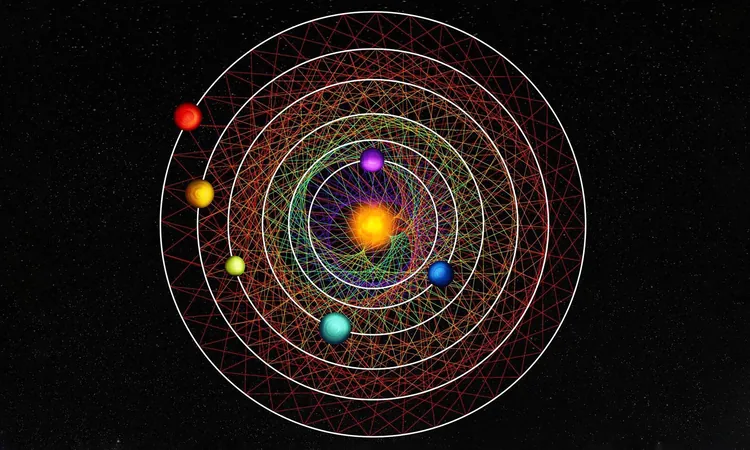
Astronomers Uncover Stunning Six-Planet System Exhibiting Perfect Orbital Harmony!
2025-01-12
Author: Ling
In a groundbreaking discovery, researchers have unveiled an extraordinary six-planet system orbiting a single star, offering fresh insights into the complexities of planetary arrangements. This newly identified configuration features the planets synchronously moving in what scientists refer to as resonance—a fascinating phenomenon where their orbital periods maintain a fixed ratio over an extended timeline, sometimes spanning millions or even billions of years. The predictability and stability of these orbits are so precise that they bear a striking resemblance to the rhythms of music.
This unique six-planet system, designated HD110067, is located approximately 100 light-years away in the northern constellation of Coma Berenices. The first indication of this celestial arrangement emerged when NASA's Transiting Exoplanet Survey Satellite (TESS) detected unusual dips in the brightness of the star. These dips hinted that planets were crossing in front of the star, an event known as a transit—a key method for exoplanet discovery.
Further investigations by TESS, in collaboration with the European Space Agency’s CHaracterizing ExOPlanet Satellite (Cheops), revealed the remarkable configuration of six sub-Neptune planets neatly aligned in close orbits. Rafael Luque from the University of Chicago, who led the analysis, highlighted the significance of this find: “This discovery is going to become a benchmark system to study how sub-Neptunes, the most common type of planets outside of the solar system, form and evolve.”
Sub-Neptunes, planets larger than Earth but smaller than Neptune, are of particular interest in astrophysics due to their diverse compositions. Some may possess thick gas envelopes, while others could be rocky. The synchronization of these planets offers valuable information on how they maintain their orbits, free of the disruptive influences often seen in other multi-planet systems.
Resonant configurations typically arise from harmonious gravitational interactions among planets. These interactions can create a stable orbital rhythm, but such patterns are rare. It's estimated that a mere one percent of multi-planet systems successfully retain this stable choreography.
For HD110067, the absence of larger neighboring planets has likely contributed to the stability of its six sub-Neptunes. This stability allows astronomers to observe the planets' behaviors over extensive periods, providing insights into planet formation and evolution dynamics.
The implications of this discovery extend to understanding the building blocks of planets. Each system that displays a coherent pattern bolsters our knowledge of how gas and dust coalesce, shaping the birth of new worlds. HD110067 serves as an untouched case study, offering invaluable data for calculating the masses and densities of its constituents, ultimately helping scientists determine the potential for these planets to sustain liquid water.
As researchers continue to monitor HD110067, they plan to employ advanced observational techniques to refine their understanding of this unique system. Investigating the internal structures of these planets could reveal further secrets—such as the existence of conditions conducive to supporting surface water.
This enthralling find not only compels scientists to delve deeper into the mysteries of the universe but also ignites curiosity about the structures of other planetary systems. The question remains: how many more resonant systems lie undiscovered in our galaxy, waiting to reveal the majestic patterns that govern celestial mechanics?
The full details of this astounding discovery have been published in the esteemed journal *Nature*.
Stay tuned for more exhilarating astronomical revelations that challenge our understanding of planetary formation and the mysteries of the cosmos!



 Brasil (PT)
Brasil (PT)
 Canada (EN)
Canada (EN)
 Chile (ES)
Chile (ES)
 Česko (CS)
Česko (CS)
 대한민국 (KO)
대한민국 (KO)
 España (ES)
España (ES)
 France (FR)
France (FR)
 Hong Kong (EN)
Hong Kong (EN)
 Italia (IT)
Italia (IT)
 日本 (JA)
日本 (JA)
 Magyarország (HU)
Magyarország (HU)
 Norge (NO)
Norge (NO)
 Polska (PL)
Polska (PL)
 Schweiz (DE)
Schweiz (DE)
 Singapore (EN)
Singapore (EN)
 Sverige (SV)
Sverige (SV)
 Suomi (FI)
Suomi (FI)
 Türkiye (TR)
Türkiye (TR)
 الإمارات العربية المتحدة (AR)
الإمارات العربية المتحدة (AR)